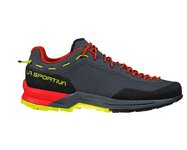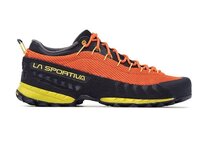Agreed that with side hilling exhaustion plays out different. maybe really intense side hilling counts as technical terrain for point 3 ? I agree the categories are fluid. I also, somehow, never have to do muvh side hilling so it didnt loom large in my recap hereI think #2 is bit more nuanced… my main elk spot for instance, I leave the truck and theres no trail, just 1 off trail mile before I’m going straight up the mountain then it’s all sidehilling, some talus, but mostly just hiking horizontally on a 30 degree slope. My ankles get pretty hammered in a light hiker. Sure my feet are comfy but I’m moving so slow that weight isn’t an issue. I might feel different if I didn’t hunt that type of terrain.
But like I said if I’m day hunting bears in the fall for instance I pack the Salomon’s 100%.
Also if someone is just training by rucking in a stiff boot then your handicapping yourself, similar to relying on cycling to get better at footborn movement. Hunters would be better served to mix up there training on rugged terrain without much weight and wearing less supportive footwear. Save the rucking and stiff boots till your a couple months out.
Navigation
Install the app
How to install the app on iOS
Follow along with the video below to see how to install our site as a web app on your home screen.
Note: This feature may not be available in some browsers.
More options
Style variation
You are using an out of date browser. It may not display this or other websites correctly.
You should upgrade or use an alternative browser.
You should upgrade or use an alternative browser.
Boots - are we doing it wrong
- Thread starter jpmulk
- Start date
Josh Gray
FNG
- Joined
- Mar 10, 2022
- Messages
- 33
Being a climber I read technical and went to just imagining it from that perspective but I believe your right on extended extensive side-hilling and your #3
AHaha yes heavy boots not good for rock climbing. But its kinda funny -- if you want to get to the peak of rock climbing technical mountains usually there is extended mountain ascent hiking over perhaps very bad terrain. What do people wear for that? Hard boots for scree fields and tough rocky areas and then switch into climbing shoes at the end?
Josh Gray
FNG
- Joined
- Mar 10, 2022
- Messages
- 33
It all depends. I’d say most competent mountaineers are comfortable climbing easier 5th class rock with mountaineering boots if they had to do like a snow couloir. You’d be surprised at just how well a stiff boot does on easier rock pitches, you can stand on a pretty small feature since there’s virtually no flex so your foot doesn’t smear off. In places like Patagonia, Pakistan and Canada there a lot of big highly technical faces that begin with snow or glacier then transitions to difficult rock that requires climbing shoes then near the summit you switch back to boots and crampons for snow and ice. I’ve personally never climbed a route that complex but would love to some day.AHaha yes heavy boots not good for rock climbing. But its kinda funny -- if you want to get to the peak of rock climbing technical mountains usually there is extended mountain ascent hiking over perhaps very bad terrain. What do people wear for that? Hard boots for scree fields and tough rocky areas and then switch into climbing shoes at the end?
Last edited:
Josh Gray
FNG
- Joined
- Mar 10, 2022
- Messages
- 33
Also there are a lot of moderately technical peaks and long routes like on the Grand Teton where in the summer it makes more sense to do the whole climb in approach shoes with sticky rubber. That’s way more enjoyable.
Most of the rock climbers I know from back in my heavy backpacking and rock climbing/bouldering days always wore what they call "approach shoes". These would be used for hiking in and hiking/climbing back down routes when it was too rocky or the terrain was too rough for bare foot. Here's a photo... Among the worlds best climbers, this is one of the most popular modern "approach shoes" sold.AHaha yes heavy boots not good for rock climbing. But its kinda funny -- if you want to get to the peak of rock climbing technical mountains usually there is extended mountain ascent hiking over perhaps very bad terrain. What do people wear for that? Hard boots for scree fields and tough rocky areas and then switch into climbing shoes at the end?

I personally wear the following shoe (TX3 Model) for the vast majority of backpacking trips and hunts when super wet weather isn't forecasted.

When super wet weather is forecasted (think 3 days plus o non-stop rain or snow) I do like a slightly taller shoe with water proofing abilities. Colombia used to make the perfect light weight, flexible water proof boot that's been discontinued. I wore that one from 2009ish until 2 years ago. They have a new variant of that model that works fine. I'll be checking out the Vivo ESC's this Winter to see how they compare.
Josh Gray
FNG
- Joined
- Mar 10, 2022
- Messages
- 33
I have the same tx3’s and love them. They are a bomb proof shoe, I’ve even worn some crampons on them for steep snow and they worked great.I personally wear the following shoe (TX3 Model) for the vast majority of backpacking trips and hunts when super wet weather isn't forecasted.
They really are! I still haven't found anything that weeps and drains as well as they do, also their ability to maintain grip when wet and on sandy granite/limestone is the best I've used.I have the same tx3’s and love them. They are a bomb proof shoe
The Tx4's are a disappointment to me in comparison (not a bad shoe at all though), so I hope they keep making the 3's, otherwise I'll have to stock up on them.
Josh Gray
FNG
- Joined
- Mar 10, 2022
- Messages
- 33
Finally finished the whole podcast. I know both those guys have way more hunting experience and I agree on a lot of what they’re saying I still think there’s a place for a stiff boot. That might just be more Steve’s feet that needs more flex.
One topic that stood out to me was Steve saying he believes a synthetic boot is totally superior to a leather boot in cold and snow. I’m curious what some of the thoughts here would be regarding that idea.
One topic that stood out to me was Steve saying he believes a synthetic boot is totally superior to a leather boot in cold and snow. I’m curious what some of the thoughts here would be regarding that idea.
jpmulk
WKR
- Joined
- Nov 12, 2021
- Messages
- 427
For wet conditions what he is saying makes sense. Having hunted with wet feet a lot, leather boots just don’t dry. I haven’t hunted much in synthetic boots. May be worth a shot. I would think in really cold temps, leather is still better. But when it’s really cold, you also don’t need to worry about being wet.Finally finished the whole podcast. I know both those guys have way more hunting experience and I agree on a lot of what they’re saying I still think there’s a place for a stiff boot. That might just be more Steve’s feet that needs more flex.
One topic that stood out to me was Steve saying he believes a synthetic boot is totally superior to a leather boot in cold and snow. I’m curious what some of the thoughts here would be regarding that idea.
roosterdown
WKR
Another fan of the TX3's - have stalked and killed big game in them, taken them on many bird hunts and over 100 canoe portages in the Canadian bush.
Only complaint is the clown-shoe color.
Only complaint is the clown-shoe color.
Similar threads
- Replies
- 26
- Views
- 851
- Replies
- 12
- Views
- 1K
Featured Video
Latest Articles
- TT#64 Josh Boyd Elk Hunting Strategies for Every Season
- Aaron Davidson of Gunwerks
- TT#63 Dirk Durham’s Art of Elk Calling
- BIG Buck Stories with the Dirty Giants Podcast
- TT#62 Brian Barney Hunting Bulls without Calling
- Hoyt Alpha AX-2 SD Review
- Kuiu Kenai vs Outdoor Vitals Vario Hooded Jacket Review
- Hoyt RX-9 Ultra Review
- Hunting Vampire Bucks & Building an Optics Kit
- Darton Sequel ST2 35 Review
